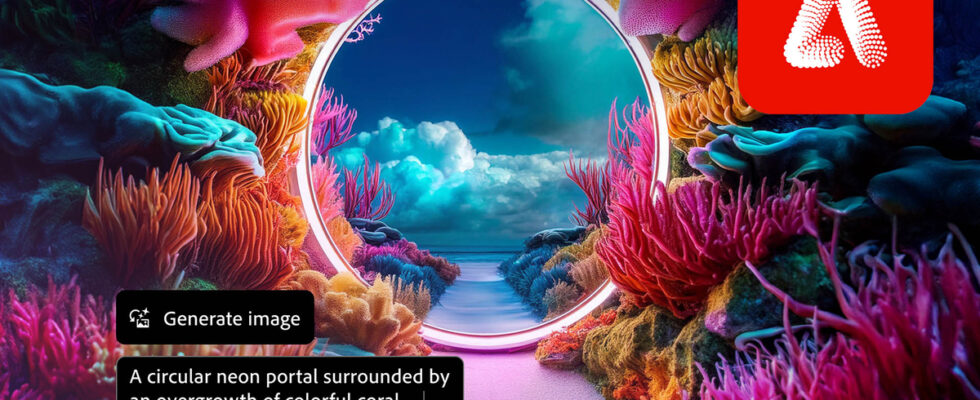Adobe’s Firefly generative AI is moving to version 3. After a v1 currently active under Photoshop CC and a v2 accessible under firefly.adobe.com, Firefly 3 will be the platform common to these two platforms. This should accelerate Adobe’s success in generative AI, a success that Stéphane Baril, veteran of Adobe France, summarizes as follows: “Firefly is simply the product with the fastest adoption rate in our history!“.
It must be said that with already 7 billion images generated, the service is a real success. This is all the more so since “90% of Firefly users are new Adobe customers“, according to S. Baril. With a 30% increase in subscriptions to the Creative Cloud service.
Firefly 3, a refined model
If Photoshop remains Adobe’s star software – and graphic design in general – the world only has eyes for Firefly 3, the company’s generative AI model. We had no details about the number of parameters, the new datasets used or the hardware used for training. We just know that Adobe is still working with Nvidia, both with its GPUs and its Picasso drive system, even if the giant has not communicated on this subject.
Adobe preferred to focus on the improvements brought by its version 3. The main one is obviously the rendering quality. A quality sometimes criticized for previous models, in particular the first version, which had difficulty standing up to big names such as Midjourney or Dall-E 3 – even if, as we will see later, Adobe has always had the advantage over on a legal level…
To refine the quality of creations, Firefly 3 has improved its rendering engine, its respect for details (finished with seven-fingered hands?), its interpretation of requests (the famous prompts), and diversified its styles. The quality and variety of its variants are also increasing. In addition to better representation of ages, ethnicities and genders when generating human characters, compositions are now more varied.
One of the interesting features is the use of a file as a reference structure, a file whose composition the AI will maintain to create a large number of variants.
Let’s not beat around the bush: given the quality of the results that Adobe presented to us, a large number of graphic designers and photographers have something to worry about. Particularly those who sell their productions to small structures, who should see Firefly as an opportunity to reduce expenses on creative tasks (generating an illustration for a festival, a party, a company, etc.).
Photoshop is getting stronger
The integration of Firefly 3 in the next beta version of Photoshop will boost the latter’s creative skills. While until now, these functions were limited to filling an existing photo/illustration, Photoshop now regains the ability to generate an image from a prompt. No more need to go to the web interface, except for certain special tasks (such as using a reference structure).
In addition to creating an image from scratch, the king of image editing software also benefits from a generation system from a reference image (transforming a foraging bee into a bee adorned with a jewel ), a background generation engine, and will notably be able to offer more coherent variants. All with the leap in quality, especially in details, that Firefly 3 brings.
To this generative part is added the addition of a tool intended for beginners. If Photoshop is popular with professionals, its audience is growing and Adobe has thought of novices by adding the Adjustment Brush. A tool which allows you to make a selection and, like the Lightroom masking brush, to create a layer (non-destructive operation therefore) to choose, a posteriori, the operation(s) that you want to carry out on the selected area (color control, brightness saturation, etc.). If the pros will undoubtedly go faster with their habits and their keyboard shortcuts, the neophytes will find in this tool a quick access to all these modifications which required, in the past, to delve into the software interface.
An AI in the legal nails
Image quality aside (you will have to test to verify), Firefly 3 has a significant advantage for professionals and businesses: a very solid legal framework. While OpenAI and others are already the subject of complaints for copyright infringement, their initiators pointing out the fact that their models were trained on protected content (articles from New York Times, works of living artists, etc.), Adobe did not play with fire. The training was not carried out in a wild way, but on libraries of licensed content – with a small hiccup in the automatic enrollment of artists from Adobe Stock, which was the subject of a mea culpa from Adobe.
In addition, given that many target users are not experienced graphic designers or creators, Adobe has also strengthened the legal framework for creations, as the company points out in its press release:
Adobe Firefly has been trained on licensed content, such as Adobe Stock. It was designed to generate content for commercial use that does not infringe copyrights and other intellectual property (IP) rights such as trademarks and logos. Adobe uses an ongoing, multi-tiered review and moderation approach to block and remove content that violates Adobe policies and provides customers with IP compensation for Firefly-generated content.
In short: Adobe promises AI trained in a legal and ethical manner and protects the creations of its users with its (powerful) legal department. You therefore run no risk of prosecution by generating your association’s party poster with Photoshop/Firefly.
Firefly 3 is now available in beta on firefly.adobe.com as long as you have an account (free or paid). The beta version of Photoshop incorporating the aforementioned new features is also available via the Creative Cloud beta channel. It is expected to be finalized later this year.
